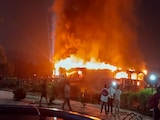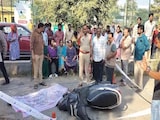- Satellite images by ISRO revealed large-scale destruction from flash floods in Uttarkashi, Uttarakhand
- ISRO's August 7 images show a 20-hectare fan-shaped mud deposit at Dharali village near Bhagirathi River
- Images guide ongoing search and rescue efforts and help restore connectivity to flood-affected villages
Satellite images, extracted by the Indian Space Research Organisation (ISRO), have revealed the scale of destruction caused by the deadly flash floods in Uttarakhand's Uttarkashi earlier this week. The disaster, on August 5, killed five people and left over 50 people missing. Experts suspect the burst of a glacial pond triggered the deluge.
Two days after the floods, ISRO's Cartosat-2S satellite captured high-resolution images of the affected zone. The pictures, taken on August 7, show a large, fan-shaped deposit of mud and debris, covering nearly 20 hectares (approximately 750 metres by 450 metres), at Dharali village, where the Kheer Gad stream meets the Bhagirathi River.
ISRO says this mapping is guiding search and rescue teams to priority locations, identifying submerged areas, and helping officials restore connectivity to cut-off villages.
The National Remote Sensing Centre (NRSC) in Hyderabad conducted a rapid assessment, comparing the post-disaster images with cloud-free pre-event data from June 13, 2024.
The analysis shows widened stream channels, altered river morphology, and severe destruction of infrastructure. Several houses in the flood-affected zone have disappeared, likely swept away or submerged under mud and debris. Roads, bridges, plantations, and homes were either destroyed or heavily damaged.
The before-and-after images show the aftermath. Dharali and the Bhagirathi River appear intact in June 2024, with houses lining the riverbank. The August 2025 images show thick mud and sediment deposits across the floodplain, with many structures gone.
"A number of buildings appear to be submerged with mud-debris in Dharali village. The satellite images will assist ongoing search and rescue efforts to reach stranded individuals and restore connectivity to the isolated region," ISRO said in its official statement.
The space agency also said the image showed the increasing vulnerability of Himalayan settlements to natural disasters.
ISRO Findings:
- Widened stream channels and altered river flow due to the flash floods.
- Fan-shaped deposit of sediment and debris at Dharali (about 20 hectares in size).
- Partial or complete destruction of several buildings in the affected area.
- Extensive mud and sediment deposition covering riverbanks and houses.
The NRSC said the rapid mapping was conducted in a short timeframe and quality-checked under ISRO procedures. Geographic details are subject to limitations due to image resolution and interpretation.
Search and rescue operations are underway in the affected villages, with efforts focused on locating the missing and restoring essential connectivity.















